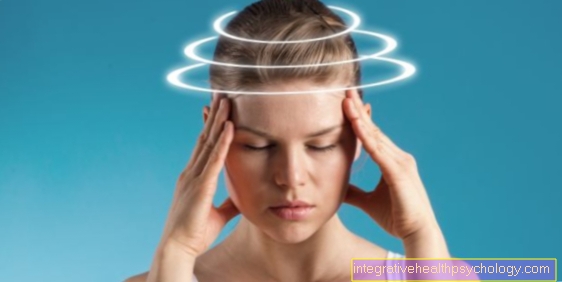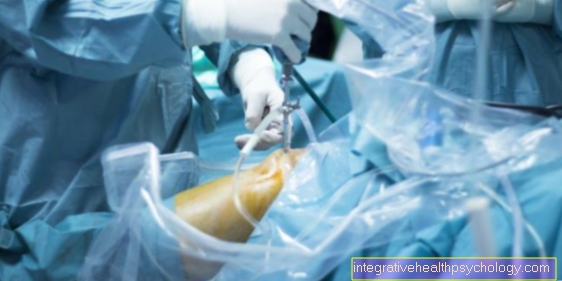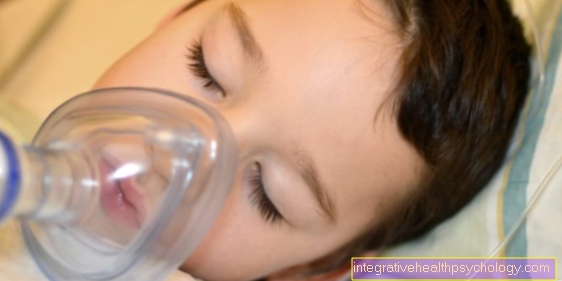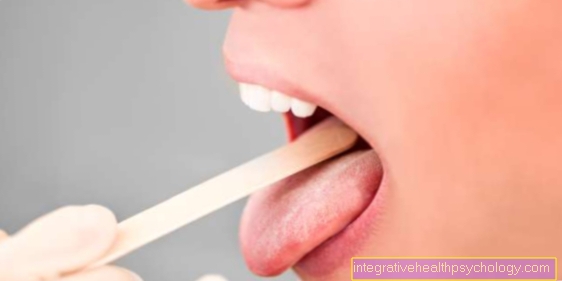These are the consequences of a stroke!
introduction
Stroke is a life-threatening condition that requires immediate therapy.
Despite the best therapy, up to 20% of patients die within four weeks of the onset of the stroke, almost 40% within a year.
But even if a stroke is survived, this can have a decisive impact on their everyday abilities for many sufferers:
Around half of the surviving patients remain permanently dependent on care due to the consequences of the stroke and are considered severely disabled.
In Germany, a stroke is the single most common cause of need for care!
You might also be interested in: Life expectancy after a stroke

These can be possible consequences of a stroke
Depending on which area of the brain is affected by the stroke, different consequences with different degrees can result.
-
Disturbances in perception:
-
Visual impairment
-
Sensory disturbance
-
Hearing loss, tinnitus
-
Balance disorder
-
-
Motor disorders:
-
Paralysis, especially hemiplegia
-
Tremble
-
Difficulty swallowing
-
Coordination disorder
-
-
Limitation of cognitive functions:
-
Memory impairment
-
Speech disorder
-
Mental slowdown
-
Consequences of a stroke on the right side
The spectrum of symptoms caused by a stroke on the right hemisphere can be very different from that of a stroke on the left hemisphere. Relatives very often report that the person concerned has changed their personality. There is a so-called flattening of affect, i.e. a flattening of feelings and emotions, which makes the person appear apathetic and disinterested. It is not uncommon for there to be a change in interest in certain topics and increased impulsiveness can occur.
Furthermore, in the case of a stroke on the right side, the visual-spatial orientation and perception can be disturbed. The extreme form of this damage is the so-called neglect. In this case, all stimuli are perceived, but one side of the outside world and one's own body are neglected. Affected people then do not notice any contact on the left side of the body, for example, or when painting a picture, only the right side of the picture is painted while the left side is unconsciously ignored. In addition to neglect, numerous other forms of attention disorder can occur. In addition, the motor skills and sensitivity on the left half of the body can be severely impaired.
Consequences of a stroke on the left side
One of the most serious symptoms of a stroke on the left hemisphere is the language disorder (aphasia).
As described above, this can present itself in various degrees of severity and forms and have dramatic effects on everyday and professional skills. This is usually accompanied by a reading and writing inability.
In addition, as on the right hemisphere of the brain, paralysis and sensory disorders can occur on the right side of the body, which creates significant restrictions, especially for right-handers. Apraxias, i.e. disorders of movement sequences, can also be observed more frequently when the left hemisphere is damaged.
Since most people have their language center on the left side, a stroke on the left side can primarily damage the language center. Read more about this at: Stroke of the language center
paralysis
Motor disorders as a result of a stroke are not uncommon and can lead to significant restrictions in everyday functions.
The pattern of expression can vary considerably and ranges from slight coordination disorders to severe paralysis.
Most often, so-called hemipareses occur, i.e. hemiplegia, which are usually incomplete. The facial muscles are affected, which is usually reflected in a drooping eyelid or corner of the mouth, but also the legs and arms. Other motor functions such as swallowing or speaking can also be affected. While targeted physiotherapy and rehabilitation measures often lead to a slight improvement in symptoms, it must nonetheless be noted that the paralysis remains permanent and that the goal of good stroke therapy must be to achieve the greatest possible independence for the person affected.
If you are interested in the chances of recovery from paralysis, we recommend our website: Healing after a stroke
Coordination disorder
In addition to the occurrence of paralysis, coordination disorders can also result from a stroke and significantly affect motor skills.
On the one hand, this can affect individual movements, which are divided into fine and gross motor skills. A disorder of this motor function is called ataxia.
Fine motor skills include writing or cutting with a kitchen knife, while gross motor skills include movements such as walking.
However, movement sequences can also be disturbed, such as playing a musical instrument or brushing your teeth. Such a disorder is known as apraxia. It is not uncommon for ataxia and apraxia to go hand in hand and lead to significant restrictions in those affected who, as a result, can only carry out everyday actions to a limited extent.
Ataxia and apraxia usually arise from damage to the cerebellum. Find out more at: Stroke of the cerebellum
Balance disorder
A balance disorder occurs especially when the cerebellum or parts of the brain stem are affected. It is usually one of the first symptoms to be triggered by a stroke.
On the one hand, the areas of the brain that process information from our equilibrium organ can be affected.On the other hand, nerve cells can be affected, which receive balance information from our muscles and thus generate information about our current body position. In combination with possible paralysis, there can be a considerable risk of falling for those affected by imbalance.
Read more about this at: Stroke of the cerebellum
dizziness
In the case of damage to the brainstem in particular, pronounced dizziness can be a symptom of a stroke. Three different forms are to be defined here.
- Patients with vertigo have the feeling that everything is constantly spinning around them, as is the case, for example, in a carousel. This form is often accompanied by severe nausea at first.
- Vertigo, on the other hand, is often compared to standing on a boat. Patients usually have a dominant side, which is associated with a significantly increased risk of falling.
- The so-called fear of falling describes the feeling of standing in a descending elevator, which creates the impression of falling.
In most cases some time after the stroke the brain gets used to the disturbance of the sense of balance and the symptoms are significantly alleviated.
Read more on this topic at: Dizziness after a stroke
Speech disorder
Speech disorders occur in around 30% of all patients as a result of a stroke.
This disorder, also known as aphasia, occurs when the language-dominant hemisphere of the brain is damaged. For most people, this is the left side of the brain. The form and severity of the language impairment can vary greatly.
- The most severe form is what is known as “global aphasia”. In this case, speech understanding and speech production are massively impaired, so that linguistic communication can be very difficult or even impossible.
- On the other hand, in "Wernicke aphasia" only the understanding of speech is disturbed. Those affected are particularly conspicuous by the formation of very long, nested sentences that often do not make sense in terms of content, which the patient is often not aware of. The flow of speech is not disturbed.
- If there is a loss of speech production, however, one speaks of “Broca's aphasia”. While the understanding is not disturbed, those affected can no longer produce coherent sentences. The result is communication with individual words or sentence components. In this context, one speaks of a telegram style.
- The last form of aphasia is “amnestic aphasia”. This is characterized primarily by a pronounced word-finding disorder, whereby forgotten words are often replaced by similar terms (e.g. car instead of bicycle).
Find out more about this topic at: Stroke of the language center
Swallowing disorder
Swallowing disorders occur relatively often as a result of hemiplegic facial paralysis caused by a stroke.
People have trouble swallowing food and holding liquids in their mouths. If the disorder is pronounced, inadequate therapy can result in malnutrition and malnutrition, as well as a lack of fluids.
However, it is more dangerous when swallowing disorders are caused by nerve cell death in the brain stem. Since the coordination of the act of swallowing occurs in this area of the brain, serious complications can arise in the event of damage. This includes, for example, the lack of closure of the breathing tube by the epiglottis during the act of swallowing. In addition to strong coughing attacks and the risk of pneumonia, this can also lead to attacks of suffocation, which can be life-threatening.
As this risk is known, a detailed examination of the ability to swallow is carried out in all patients with a stroke in order to prevent possible complications at an early stage.
Visual impairment
It is not uncommon for patients to develop vision problems after having a stroke.
The type and extent of the visual impairment are largely dependent on the location of the brain damage. The optic nerve itself can be damaged in its course, but also the area of the cerebral cortex that is responsible for processing information for vision. In this context, the visual field is most often narrowed. This means that if you look at something, you can see blackouts at the edge. This creates the impression of tunnel vision.
However, small areas of the field of vision or complete loss of vision on one side can also occur. Double vision can also occur, which indicates damage to the brain stem. If the damage is in the visual cerebral cortex (the area of the brain that is responsible for seeing), the loss of vision is often complex. It is possible that the perception of visual stimuli is completely unaffected, but this information is no longer processed can.
Read more on this topic at: Visual disturbance after a stroke
Hearing deterioration and deafness
In the course of a stroke, damage to nerve cells can lead to hearing impairment or complete hearing loss.
In both cases it is a so-called sound perception deafness, which means that acoustic stimuli can be correctly perceived and passed on through the auditory nerve, but the processing of the information is disturbed. Since nerve cells are destroyed during a stroke, it is not to be expected that the hearing symptoms will improve again as the disease progresses.
Tinnitus
In some cases, tinnitus can be one of the first symptoms of a stroke, as it can indicate, among other things, a change in the blood flow in the inner ear. While the tinnitus itself usually disappears after a few hours, it can arise again if the stroke leads to numbness.
This fact can be explained by the fact that the brain tries to compensate for the lack of hearing information through the deafness, which can result in the development of tinnitus.
You might also be interested in: Treatment of tinnitus
Memory impairment
Memory disorders occur relatively often as a result of strokes, but they can take on different dimensions and affect different memory contents.
Depending on the type of memory disorder, conclusions can be drawn about the location of the brain damage:
- If the focus of the stroke is in the area of the left temporal lobe, for example, a disturbance of the so-called semantic knowledge can often be determined. This primarily includes factual knowledge, such as general or specialist knowledge.
- The episodic memory, which includes the contents of the personal biography, on the other hand, is impaired when the right frontal lobe is damaged.
- Furthermore, there are numerous other memory disorders as a result of a stroke, which, in addition to forgetting old memory content, can make it difficult or even prevent the storage of new content.
Read more on this topic at: Memory loss
Development of epilepsy
Particularly when larger areas of the cerebral cortex are affected by a stroke, so-called epilepsy foci can arise.
These are areas of the brain that are overexcitable due to brain damage and can thus trigger epileptic seizures. A stroke that has taken place represents the greatest risk factor for the development of epilepsy in old age.
It is estimated that 10-15% of stroke patients will experience epileptic seizures during the course of the disease. These are usually so-called early attacks, which occur within the first few days after a stroke. However, many of these patients remain seizure free after the first event. On the other hand, patients in whom the seizures only occur after a longer period of time are more frequently affected by recurring seizures. This makes long-term treatment with anti-epileptic drugs necessary. In rare cases, epilepsy surgery can also remove the epilepsy focus, which is very often associated with a permanent resolution of the seizures.
Read more on this topic at: Epileptical attack
Tremble
Much less often, sufferers report pronounced tremors after a stroke.
This is the case when a stroke affects certain areas of the brain that play a decisive role in generating motion sequences. Since this is a scarring of a brain region, the tremor usually remains permanent if it is not adequately treated.
Another less common consequence of a stroke can be the so-called Holmes tremor. This is characterized by slow, irregular tremors and can occur if the upper brain stem is damaged. Furthermore, the connection between strokes and the development of Parkinson's disease is now being investigated in research, since a possible connection is suspected here.























.jpg)





